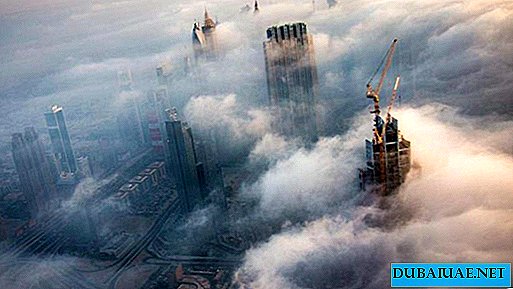
 Viktor Lebedev is an orientalist journalist who has worked as an ITAR-TASS correspondent for over thirty years in various Arab countries - Syria, Egypt, Sudan, Tunisia, Yemen. Almost half of this term lives and works in the United Arab Emirates. Victor Lebedev is the author of the book “World of the Emirates” from the series “Arabian Arabesques”, the first winner of the International Prize named after journalist-orientalist Viktor Posuvalyuk. The permanent author of many country-specific materials published in our journal, Viktor Lebedev is also a literary translator of the verses of the UAE Vice President and Prime Minister, ruler of Dubai, Sheikh Mohammed bin Rashid Al Maktoum. Poems for the Russian edition were personally selected by the high-ranking poet himself.
Viktor Lebedev is an orientalist journalist who has worked as an ITAR-TASS correspondent for over thirty years in various Arab countries - Syria, Egypt, Sudan, Tunisia, Yemen. Almost half of this term lives and works in the United Arab Emirates. Victor Lebedev is the author of the book “World of the Emirates” from the series “Arabian Arabesques”, the first winner of the International Prize named after journalist-orientalist Viktor Posuvalyuk. The permanent author of many country-specific materials published in our journal, Viktor Lebedev is also a literary translator of the verses of the UAE Vice President and Prime Minister, ruler of Dubai, Sheikh Mohammed bin Rashid Al Maktoum. Poems for the Russian edition were personally selected by the high-ranking poet himself.Everyone who visited Baku was personally convinced that this city is located in an oil-producing country. This is evidenced by the "cranes" of the oil rocking horses, who nod greeting the guests of the Azerbaijani capital, who drive up to it in cars.
Foreigners visiting the Emirates know that the UAE is an oil monarchy, and they are surprised a lot when they do not see drilling towers, rocking chairs, squat oil storage facilities and marine terminals with heavy tankers in Abu Dhabi, Dubai or Sharjah. Is it possible that the Sharjah field of As-Sajaa will attract attention with its gas torches among the reddish sands, and it will hit the huge coastal oil reservoirs of Fujairah. The UAE’s affiliation with hydrocarbon rich is evident only in this northern emirate, where giant oil storages are concentrated, huge new reservoirs are built, and endless chains of tankers line up on the roads far from the port, highlighting a many-kilometer sea street in black night. But the impression is misleading: there is no oil in this emirate, just as there are none in the other two emirates Umm al-Kuwain and Ajman, which are part of the federal state. The "black blood" of the economy is throbbing weakly in Ras al-Khaimah. But there its pressure is limited so far by a limit of 100 million barrels, which is negligible.
The giant "pots" of Fujairan monsters are a special article. They were created to service foreign ships, and not at all to save their own hydrocarbons, which have not yet been found in this emirate, despite the efforts of the Canadian company Reserve Oil & Gas, which is engaged in prospecting on an area of 2800 sq km.
Emirates of Ajman and Umm al-Quwain, uninformed by oil, only cherish hopes for the discovery of combustible stocks promising dollars. As in Fujairah, prospecting works are being carried out in them, but so far they have not produced the desired results.
The country's oil resources, amounting to 97.8 billion barrels, i.e. About a tenth of the world's hydrocarbon reserves are concentrated in the emirates of Abu Dhabi, Dubai and Sharjah. Moreover, their largest “treasures” are in Abu Dhabi, under the sands and waters of which 95% of the national energy wealth is hidden.
 The first Middle Eastern oil. The beginning of the twentieth century
The first Middle Eastern oil. The beginning of the twentieth century
The possibility of oil production in the Middle East was first discussed at the beginning of the twentieth century. In 1908, it was discovered in commercial quantities in southern Iran. In 1911, Bahrain, which had close ties with Iran, raised the question of oil searches for the British authorities. She was found. In 1934, in this island emirate, which became a kingdom several years ago, the extraction of raw materials for internal combustion engines began, gaining the speed of movement of mankind.
In the early 1920s, the rulers of all the emirates of the Persian Gulf sent messages to their British patrons with proposals for the exploration of local mineral resources. In the territory of the modern state of the UAE, the then ruler of Sharjah, who at that time was a leader in the economic development of the coast, Sheikh Khaled bin Ahmed was the first to offer the British to search for oil. “My goal in writing this letter is to welcome you and ask about your health,” he wrote to a British resident in a message written in traditional Arabic style with a long complimentary approach. “You are not unknown that I write this message of my own free will. I assure you that if oil is discovered in my region, I will not grant concessions to foreigners, except for persons indicated by the British government. This is what should be said. " The appeal has been reviewed.
Abu Dhabi wrote a similar letter to the last of the Emirates of the Treaty Coast, as the western, Arabian Persian Gulf was then called. But the first oil in commercial volumes was not found in Sharjah, namely in Abu Dhabi.
Oil exploration work began on the territory of Abu Dhabi in the second half of the 1930s on the basis of an agreement between the ruler of this emirate and the Contract Coastal Oil Development Company. The company was granted a concession for operations in the entire emirate and in its waters. Then similar agreements with her were signed by Dubai and other emirates. The work was curtailed due to the outbreak of World War II. The company later abandoned most of its concessions. They were transferred to other applicants, who found the keys to the secrets of the emirate's bowels.
Most of the Emirate’s oil is produced in offshore fields. From them, it is mainly exported without having been on land. Here is the secret of the lack of oil rigs in the visible sands. The main offshore deposits of the emirate of Abu Dhabi are Umm al-Shayf, Zakum, Abu l-Bahush, Mabraz, al-Bunduk. Umm al-Shayf is the first offshore field discovered in 1958, 95 km northwest of Abu Dhabi, 22 km north-east of Das Island. The first oil "treasure" is an egg-shaped dome with an area of 400 square kilometers. Zakum deposit is one of the largest in the emirate. It is located 80 km northwest of the emirate capital and 85 km from the island of Das.
In the same 1958, which is considered the year of the discovery of oil in the emirate of Abu Dhabi, the production facilities of the onshore Bab field were confirmed five kilometers from the city of Tarif on the southern coast of the bay.
The largest fields in Abu Dhabi are Murban, where daily oil production is at the level of 1.5 million barrels, and Verkhny Zakum - 600 thousand barrels. Large land deposits also include Bukhasa, Asab, Sahl and Shah.
 Black Gold Dubai and Sharjah
Black Gold Dubai and Sharjah
In Dubai, which occupies, with a huge lag, the second place after Abu Dhabi in reserves and oil production, commercial oil was found in 1966 at the Fateh offshore field, located 60 nautical miles from the coastline. It was quickly mastered, and the first batch of Dubai oil in the amount of 180 thousand barrels went for export in 1969.
In the 1970s and 1980s, other Fateh offshore fields were discovered (southwest), the smaller Falah and Rashed, as well as the onshore Margam. In 1991, the total oil production in all five fields of the emirate reached its peak of 410 thousand barrels per day. Since then, it has only declined. By the beginning of the new millennium, the annual level of oil production in Dubai, whose total energy reserves are estimated at 4 billion barrels of oil (almost 25 times less than in Abu Dhabi!) And 4.1 trillion cubic feet of gas, reached 68 million barrels. It is expected that the reserves of these hydrocarbon pantries will be depleted within 20 years.
In February of this year, a new oil field was announced in Dubai, which the local representatives called “promising” and “significant.” It was named "Jalilah" by the name of one of the ten daughters of the country's vice president and prime minister, ruler of Dubai, Sheikh Mohammed bin Rashid Al Maktoum. Officials predict that the development of Jalili will begin within a year, which seems doubtful, as world and local practice shows that usually 3-5 years pass from the discovery of an oil field to the start of its development. Nevertheless, the head of the Dubai Oil Department and the Supreme Energy Council of the Emirate, Sheikh Ahmed bin Saeed Al Maktoum, told Dow Jones: "I can confirm that the oil has been found and I hope that its production will begin within a year."
The absence of any estimates regarding the new energy entity may indicate that the announcement of a new discovery was made to improve the financial image of Dubai in the face of international lenders, to whom it owed $ 26 billion. A confirmation of the significance of the new field would help the emirate overcome its difficult economic crisis, whose gross domestic product, estimated at $ 54 billion, consists primarily of revenues from trade, services, transport and aviation, tourism, and is only 5% filled with profits from oil production.
The search for oil in Sharjah continued for more than 30 years. In commercial volumes, it was discovered only in 1972 at the Mubarak-1 field, eight nautical miles east of the Iranian island of Abu Musa. Later, other, not very rich oil fields were found, the well production rate of which was less than or more than 10 thousand barrels per day. In 1974, three years after the creation of a single state consisting of seven emirates, Sharjah became the third oil producing and exporting emirate in the UAE. In the 80s, the onshore field of Al-Sajaa was discovered.
Emirate oil and its reserves
According to the Abu Dhabi CCI, the production capacity of the country, which ranks fifth in the world in terms of confirmed oil reserves and fourth in terms of oil production after Saudi Arabia, Iran and Iraq, amounted to 2.9 million barrels per day in 2008. In 2010, it is supposed to bring them to 4 billion bpd. In addition, the UAE occupies the sixth place in the world in terms of natural gas reserves, which are estimated at 6 trillion cubic meters. In the next 5 years, the country plans to spend 80 billion dirhams (almost $ 22 billion) for the development of the oil sector.
In 2009, the share of the oil sector in the gross domestic product of Abu Dhabi amounted to 65%, in the country's gross product it is much smaller - only 44%. The contribution to the Abu Dhabi GDP of non-oil sectors, including industry, construction, real estate, banking, hospitality, transportation, amounted to approximately 175 billion dirhams (about $ 48 billion) in 2009.
The global financial crisis, which collapsed in demand for black gold, forced the UAE to reduce oil production and influenced long-term plans. According to the newspaper Emirates Business, in October 2008, the country produced only 2.562 million barrels of oil per day in accordance with the quota allocated to the Emirates by the Organization of Petroleum Exporting Countries (OPEC), and in December of the same year, according to Reuters, daily oil production , in accordance with the OPEC decision, reduced to 2.28 million barrels. Since January 1, 2009, according to the state-owned Abu Dhabi National Oil Company or ADNOC, the production of hydrocarbons in the main oil field of Abu Dhabi - Murban has been reduced by 15 percent. Oil production at the Verkhniy Zakum field was reduced by another 3 percent. At the Nizhny Zakum field, where 280 thousand barrels of oil were produced per day, maintenance work is underway.
The total reduction in oil production in the emirate of Abu Dhabi in accordance with the decisions of the OPEC emergency conference in the Algerian city of Oran in December 2008 amounted to approximately 250 thousand barrels per day. ADNOK has notified its trading partners that it will "fairly distribute" the extracted oil among them.
UAE income from oil sales fell significantly compared to 2008, when the average OPEC oil basket price was $ 94.45 per barrel, and the barrel price record set on July 3, 2008 soared to $ 140.73.
In the first three months of 2009, the average price of a barrel of OPEC oil more than doubled and “floated” at the level of $ 40-50, sometimes exceeding the $ 50 bar. At the same time, local analysts do not consider the reduction in oil production in the UAE and the reduction in the cost of an oil barrel to be “critical” for the Emirate’s economy, since in 2008 the country received very great benefits from the rise in hydrocarbon prices, making money from oil exports, according to the newspaper “Emirates Business ”, 89 billion dollars. Only Saudi Arabia ($ 288 billion) received the largest income among the countries of the region, whose oil production volumes significantly exceed the emirate’s capabilities. In early 2010, oil prices improved significantly. In early February, the barrel was worth over $ 75, which suits both buyers and sellers.
The implementation of OPEC oil production quotas lies only with the emirate of Abu Dhabi, where oil is 20 times more than in Dubai, Sharjah and Ras al-Khaimah combined. These emirates do not limit their production capacities. In the context of the global financial crisis, they are suffering, first of all, from the recession of economic development in the world, which has led to a reduction in investment, trade and stagnation of the tourism sector.
Oil and sea
There is another secret why guests of the Emirates do not see industrial paintings of oil production. The Dubai Fateh Field, for example, is located 60 nautical miles from the coastline. Several more wells are scattered in the sea. The extracted oil is pumped into subsea storage facilities placed at the bottom of the sea directly above the oil field, where tankers are suitable for loading.
The decision to create underwater reservoirs for storing the extracted oil "treasures" was forced due to the shallow water surrounding the emirate and the remoteness of the field from land. Realize the bold idea helped consultants from the American company Chicago Bridge & Iron.
Three huge hemispheres, each the height of a 20-story house without a bottom, resembling inverted champagne glasses in their shape, were assembled in the dry dock of Dubai from the best grades of steel. Each tank, bearing the Arabic name "Khazzan", is fixed at the bottom of the sea on the principle of a camping tent. Khazans with a diameter of over 80 meters in the bottom are interconnected by pipelines.
The unique oil storage system is based on the fact that oil is lighter than water and does not mix with it. Oily fuel injected into the steel hemisphere through a pipeline displaces water from it. When oil from Khazzan is pumped into a tanker mooring directly to it, the water level in the tank rises, and its stability remains unchanged. Oil storage towering 12.5 meters above the water can withstand a hurricane wind, waves up to 12 meters high, withstand deep currents with speeds of up to three knots. Unique underwater storage, with a total capacity of about one and a half million barrels, operate flawlessly.









